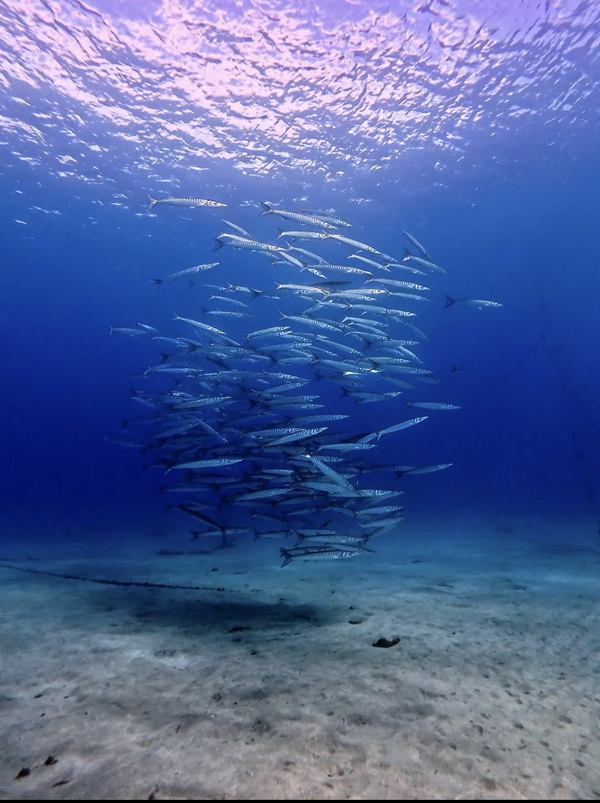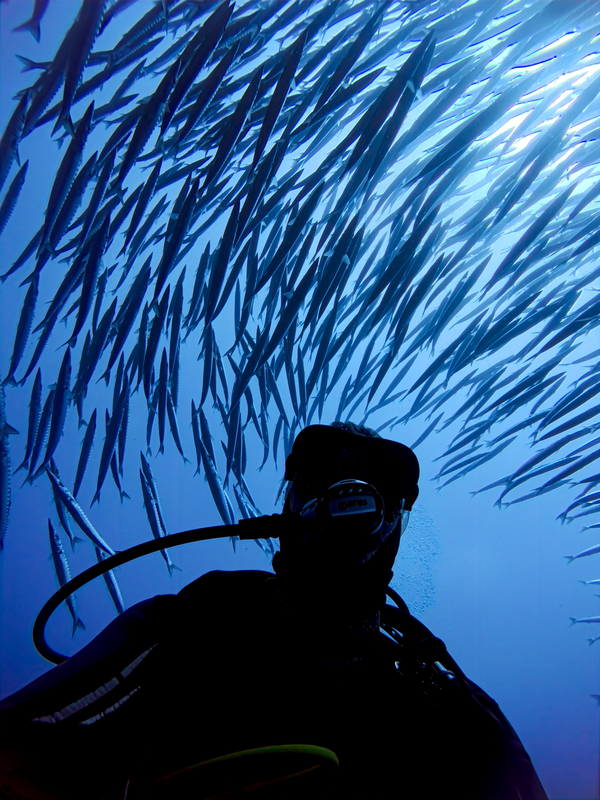If you’ve ever dived among a school of fish, you will know what it feels like: as if the whole
ocean came alive in a perfectly synchronized choreography. Hundreds or even thousands of fish
moving as one, turning, changing direction, dodging predators and creating impossible figures
in the middle of the blue.
You may be wondering, is it magic? No, it’s not magic, it’s just science and a lot of intelligence.
.This mesmerizing spectacle is a common highlight during dives with Barbarian Diving Tenerife, offering one of the most captivating underwater experiences in the Atlantic Ocean.
Table of Contents
What is a school of fish or shoals?
Although we use both terms interchangeably, there are slight differences between what we call
“shoals” and “school of fish”. The correct term when talking about a group of fish swimming
together, but in a somewhat disorganized way, is called a shoal; and when these groupings of
fish move harmoniously, in perfect synchronization, it is called a school of fish.
This behavior, which at first glance may appear to be a simple agglomeration, is actually a very
effective evolutionary strategy. It is not just about being together, but about communicating,
adapting and responding to the environment as a single unit. This behavior is the closest thing
to a collective intelligence in the marine world.

Why do fish swim in schools?
There are several reasons why fish form these spectacular groups, all of which have to do with
survival.
- Defense against predators: Swimming in a group creates the so-called “confusion effect”,
because it is much more difficult for a predator to focus on a specific prey when hundreds of
fish are moving at the same time. In addition, being together decreases the likelihood of an
individual being caught. - Efficiency in movement: Moving in a group reduces energy expenditure. Each fish takes
advantage of the movement of the fish in front of it, just as migratory birds do when they fly in
formation. Some studies have shown that this teamwork can save up to 20% of energy during
swimming. - Better access to food: Schools are able to detect food faster and more efficiently because it
is much easier to find food sources if you have thousands of eyes, instead of just one pair, at
your disposal for the search. - Social interaction and reproduction: In some species, such as seabreams, being part of a
school makes it easier for males and females to meet during the breeding season. In other
species, such as dolphins, females form alliances to protect themselves against sexual
aggressions from males during courtship or reproduction.
What species form schools in the Canary Islands?
If you dive in the Canary Islands you will see that school of fish are a common part of the
underwater landscape. Some frequent species that swim in schools are bogues, which form
huge schools that move in unison near the surface, generating impressive flashes of light;
saupes, recognizable by their horizontal golden lines, which are usually near the bottom, in
rocky areas and seagrass meadows; barracudas, which are fast predators that sometimes
group together in orderly formations; white trevallies, which are very fast and form dense
groups that often attract hunters such as tuna or dolphins; and, last but not least, bastard
grunts, which often form schools of up to a thousand fish and whose groupings, called
“grunts”, make for spectacular dives when they are sighted.

How do fish communicate within a school?
Although they have no traffic lights or road signs, not even a leader, the fish in a school
communicate with each other by visual signals and water pressure. They have a sensory
structure called a lateral line, which detects water movements around them. Thus, they can
instantly tell if the fish next to them has turned, accelerated or slowed down. This way they
achieve perfect synchrony of each individual within the school.
Diving inside schools of fish
Diving surrounded by hundreds of fish moving as one is something you never forget. The light,
the sound, the feeling of being immersed or enveloped in a “dance of the ocean” is an
experience that will stay with you forever. So, when you plan your next dive in the Canary
Islands, keep your eyes open, you are likely to live this unique experience!
And if you want to make sure you see them, ask for our favorite spots here at Barbarian Diving
Center. We’ll take you to the heart of the action.
For a more comprehensive list of Tenerife’s premier dive sites, check out our article on the Top 10 Dive Sites in Tenerife







0 Comments